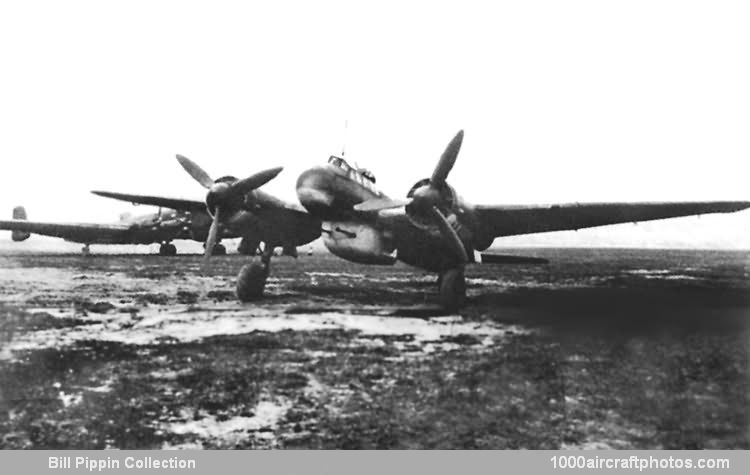10/31/2013. Remarks by Johan Visschedijk: "The pressing need to evolve an effective countermeasure to the rapidly-multiplying Soviet tanks was rendered obvious after the Crimean battles of 1942, and the highest priority was allocated to the development of anti-tank aircraft carrying weapons capable of penetrating the armor of the KV 1, KV 2 and T-34 tanks. Various schemes were proposed for the ubiquitous Ju 88, and among those tested was the application of a so-called Nebelwerfer (sometimes referred to as the Do-Werfer after its creator, Professor Dornberger) to an adapted Ju 88 C fighter.
The Nebelwerfer was a small artillery weapon employed by the Wehrmacht, this possessing six revolving barrels firing Wfr. Gr. 21 or 28 recoilless shells, and the test vehicle was unofficially designated Ju 88 N or Ju 88 Nbwe, but no official designation was applied to this aircraft, and tests of the Nebelwerfer were abandoned at an early stage in favor of the 2.95 in (75 mm) KwK 39.
A Ju 88 A-4 was adapted during the summer of 1942 for trials with the KwK 39 as the Ju 88 P V1. This weapon was installed in an immense fairing beneath the fuselage which promptly resulted in the aircraft being nicknamed "Die Dicke Bertha" ("The Fat Bertha") when firing trials began at Bernburg. The original offset ventral gondola was removed, and the cannon housing was extended aft to terminate in a defensive position mounting an MG 81Z (twin 0.311 in, 7.9 mm MG 81 machine guns) firing aft. The gun, which was inclined downwards at a small angle to the line of flight, was band-loaded and its barrel projected some 6 ft (1.83 m) ahead of the fuselage nose. The exhaust gases were ejected from either side of the fairing, the exits being sufficiently far aft to avoid any interference with the plane of the airscrews.
Initial firing trials showed sufficient promise to warrant further tests at the Roggenthin satellite of the E-stelle Rechlin where it was evaluated against captured T-34 tanks, two rounds normally being fired during each pass, the first being fired from a height of about 1,000 ft (300 m) in a shallow low-speed glide, the second being fired from about 250 ft (75 m). The results were relatively satisfactory, and a small batch of additional conversions was ordered.
Designated Ju 88 P-1, these differed from the Ju 88 P V1 in having a "solid" nose and the improved 2.95 in (75 mm) PaK 40 cannon with a larger muzzle recoil brake and electro-pneumatic operation. The cannon and its housing rendered the Ju 88 P-1 extremely unwieldy and highly vulnerable if intercepted by fighters, and an explosive device was therefore fitted enabling the pilot to jettison the cannon in the event of interception or an engine being knocked out by ground fire.
Three crew members were carried, a single forward-firing MG 81 machine gun operated by the pilot was used for aiming purposes, and aft defense was provided by two MG 81Z installations firing above and below the fuselage. The Jumo 211 J-2 engines were protected by armor and the fuel tanks were deleted from the outer wing panels. Possessing a normal loaded weight of 24,400 lb (11,068 kg), the Ju 88 P-1 had a maximum speed of only 244 mph (393 kmh). Tested by the Versuchskommando für Panzerbekämpfung late in 1943, and issued to the Panzerjäger Staffel 92 operating on the Eastern Front, the Ju 88 P-1 enjoyed some success against Soviet armor, but was generally unsatisfactory owing to low rate of fire of its weapon and its inability to evade interception.
A small number of additional Ju 88 A-4 airframes were converted as Ju 88 P-2s, this conversion being similar to the Ju 88 P-2 but the ventral housing mounting two BK 3.7 (Flak 38) cannon of 1.46 in (37 mm) caliber offset to port. Although intended from the outset as an anti-tank aircraft, the Ju 88 P-2 was employed experimentally as a day interceptor, and performed several abortive attacks on USAAF bomber formations. However, performance was so poor that the Ju 88 P-2 could rarely catch the formations that it was intended to intercept, and on the occasions that it did effect an intercept, its lack of maneuverability rendered it extremely vulnerable to the concentrated fire of the bomber formation. Consequently, the few examples of this type quickly reverted to their intended role of tank-busting.
A further conversion, the Ju 88 P-3, carried a similar armament of two BK 3.7 cannon to that of the Ju 88 P-2 but embodied increased crew protection, and the final P-series conversion was the Ju 88 P-4, 32 examples of which were delivered, and which appeared in service late in 1944. The Ju 88 P-4 featured an appreciably smaller ventral housing which carried a single 1.97 in (50 mm) BK 5 cannon. Several Ju 88 P-4s were tested as night fighters but were rejected by the operational units owing to their low performance and lack of intercept radar."
